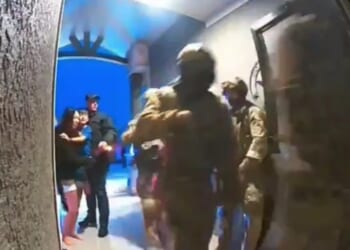In 1977, President Jimmy Carter canceled the B-1 supersonic bomber, claiming that it was expensive and unneeded. But when Carter left, the bomber returned.
The Rockwell B-1 Lancer is unique among U.S. strategic bombers for its ability to reach supersonic speeds and for its distinctive swept-wing configuration. In spite of its impressive capabilities, though, the B-1 is slated for retirement—making way for the forthcoming B-21 Raider, a subsonic stealth bomber.
The swap symbolizes the changing tactical priorities of the strategic bomber force. Speed is out. Stealth is in—to accommodate the increasing sophistication of detection systems and anti-access / area denial (A2/AD) systems.
But the B-1 will always be remembered as a unique bird, blending speed and strength and the ability to carry a massive payload; and as an aircraft with a complicated, politically-entwined origin story.
The B-1 Lancer Almost Never Left the Ground
The B-1 was first envisioned in the 1960s as a heavy bomber that could reach Mach 2 speeds, like the Convair B-58 Hustler, while also carrying payloads comparable to the B-52 Stratofortress—in effect replacing both. In the 1970s, Rockwell developed a prototype, known as the B-1A, which successfully reached Mach 2.2 in tests.
But the B-1 program would soon become mired in politics. During the 1976 election, upstart candidate Jimmy Carter derided the bomber program, claiming that it was an egregious waste of taxpayer money at a time of relatively good relations between the United States and the Soviet Union. Carter wasn’t the only one with doubts about the bomber. In 1976, a Soviet pilot defected and described advances in Soviet fighter technology that had the potential to render the B-1 ineffective, and no more likely to survive in Soviet airspace than a subsonic bomber like the B-52.
When Carter assumed the Oval Office in January 1977, he ordered a review of the B-1 program and Air Force capabilities at large. Carter ultimately decided that the B-1, at more than $100 million (inflation-adjusted) per aircraft, was an extremely expensive program with relatively few uses for the Air Force. Instead, Carter vowed to put the money towards cheaper and more effective weapons—chiefly an investment in intercontinental ballistic missiles (ICBMs), air-launched cruise missiles (ALCMs) that could be outfitted to the B-52 and used to confuse enemy air defense systems, and early stealth aircraft technology. Carter officially canceled the B-1 program in June 1977.
Reagan Revived the B-1 During the Nadir of the Cold War
But Carter’s cancellation of the B-1 bomber wouldn’t mark the end of the program.
During the 1980 presidential election, GOP nominee Ronald Reagan campaigned heavily on the idea that Carter was weak on defense, citing the cancellation of the B-1 program and “Operation Eagle Claw,” Carter’s failed attempt to rescue American hostages in Iran in April 1980.
Upon taking office, Reagan ordered his own review of the B-1 program, deciding ultimately to fund the project. In January 1982, the Air Force awarded Rockwell a $2.2 billion contract for 100 B-1 bombers. The new B-1 program was modernized, and became known as the B-1B—the variant which has now been in service for four decades.
The B-1B, known affectionately as the “Bone” (B-one) by its crews, will soon be replaced in favor of the B-21. And while the B-1B has served in various Middle Eastern conflicts, Carter may have been right in the end; the supersonic bomber was obviously not needed to penetrate Soviet airspace, as the Soviet Union fell shortly following the B-1B’s introduction.
About the Author: Harrison Kass
Harrison Kass is a defense and national security writer with over 1,000 total pieces on issues involving global affairs. An attorney, pilot, guitarist, and minor pro hockey player, Harrison joined the U.S. Air Force as a Pilot Trainee but was medically discharged. Harrison holds a BA from Lake Forest College, a JD from the University of Oregon, and an MA from New York University. Harrison listens to Dokken.
Image: Shutterstock / Anatoliy Lukich.















